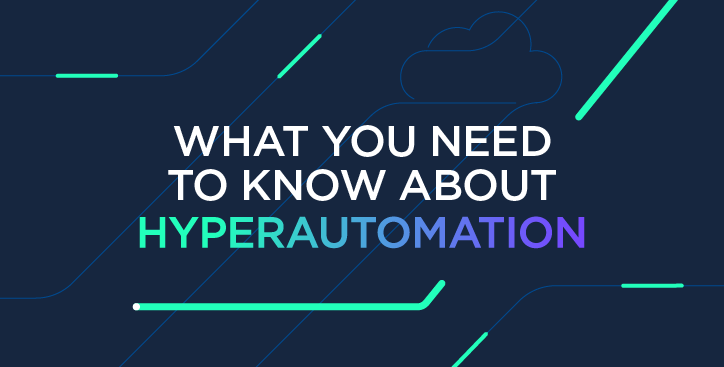The Role Of Hyperautomation In Network-as-a-Service (NaaS)
By Alex Hawkes|7 February, 2022

One of the key benefits of the Network-as-a-Service (NaaS) approach is the level of control network service providers can pass on to their enterprise customers and partners. In this blog, we look at the role that hyperautomation is playing in the provisioning and management of networks...
What is hyperautomation?
Hyperautomation is the latest industry buzzword used to describe the application of multiple advanced technologies, such as Robotic Process Automation (RPA), Artificial Intelligence (AI) and Machine Learning (ML), in order to automate and augment more processes.
Gartner has included hyperautomation among its top strategic trends for 2022, describing it as “a business-driven approach to identify, vet and automate as many business and IT processes as possible. It requires the orchestrated use of multiple technologies tools and platforms, including RPA, low-code platforms and process mining tools.”
Digital transformation is one of the main drivers of hyperautomation, which is expected to help organisations become more agile, improve decision making and reduce operational costs and errors.
Organisations are expected to be able to scale their automation capabilities over the coming years – and evolve from automating distinct tasks and transactions based on static rules, to automating more complex processes and even knowledge work.
How does Console Connect use hyperautomation?
Console Connect is already using elements of hyperautomation to deliver end-to-end service automation across our global network.
“We have introduced some sophisticated forms of Robotic Process Automation (RPA) to support the commercial management of our global network,” explains Console Connect’s CTO Paul Gampe.
“For example, we have an internal application that uses RPA to manage a catalogue of inventory and pricing, which are accessible in near real-time to users through Console Connect.”
Console Connect also uses RPA to on-board new enterprise locations to the network. There are currently over 700 on-net data centres directly available through Console Connect, with new locations being added all the time.
“In order to streamline this onboarding process, we use assisted RPA (which are autonomous processes that are overseen and managed by a member of our team) to manage the procurement and quotation of provisioning connectivity to these new locations,” says Paul.
“When it comes to unassisted RPA (which are autonomous processes that operate almost entirely independently), we have a network element orchestration service that runs across our entire global network. Internally this is referred to as our ‘service layer’, which is essential for our users to self-provision network services across Console Connect.”
Unlike other NaaS platforms, which may have begun as Greenfield deployments and deployed network infrastructure to conform to the automation architecture, Console Connect has taken a different approach: “Instead of building our own automation capability to integrate within a Brownfield environment. This is a key component of our hyper automation strategy,” says Paul.
“As a result, irrespective of the network element beneath this automation architecture, our ‘service layer’ has the intelligence to transform the ‘network layer’ into a reliable state on the device. This approach is also less capital intensive and quicker to deploy.”
How does hyperautomation benefit Console Connect users?
One of the ways hyperautomation has benefitted our business and end users is that it enables us to fully integrate our platform and network via APIs.
Open standard APIs bridge the gap between lower layer network infrastructure and higher layer OSS and BSS, and help manage interconnectivity to and between cloud-based infrastructure, platform, and software partners.
This puts Console Connect users in control of when, what, and how much of these services they consume, with open APIs acting as the glue for ease of integration and consistent communication between the service provider, and their customers and partners.
Beyond this however, open APIs are key to streamlining processes across the entire network by enabling automation: “We are able to use API endpoints to perform various tasks across our network that typically in the past would have been performed by network engineers,” explains Paul.
“For example, our APIs enable customers to receive quotes for point-to-point and multi-point connectivity services or APIs help automate the connection between our network and another network.”
While APIs can provide businesses with a common level of abstraction, interoperability can be a challenge. Certainly when it comes to network automation, API standards will be critical moving forward, particularly for avoiding things like vendor lock-in.
That’s where the adoption of the standardised Sonata APIs can provide real value with network automation and management, and in the long term enable automation between different networks.
For example, Console Connect has recently collaborated with Colt to complete the first stage of an API-led integration between our on-demand SDN platforms. In this example, the use of APIs has enabled seamless quoting, ordering and provisioning on-demand services between two high-performance networks in real-time.
When it comes to network innovation, hyperautomation and APIs will play an essential role in increasing interoperability and delivering fully end-to-end automation.


.jpg)





.jpg)
